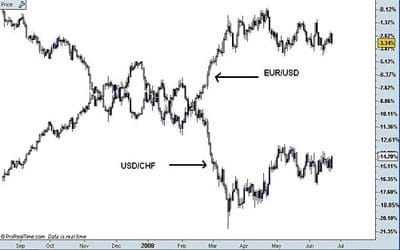In the previous lesson, we showed you how to use a currency correlations table, and how to calculate these correlations yourself. Today, we’re going to look at the many uses they can be put to when trading forex.
1: Avoiding cancellations

If you have two open positions with a high negative correlation, they can cancel each other out – giving you the equivalent of having no position at all! For example, knowing that USD/CHF and EUR/USD move in opposite directions nearly 100% of the time, you could see that having a long EUR/USD and a short USD/CHF position open would be fairly pointless. When EUR/USD goes up, it’s virtually guaranteed that USD/CHF will go down. By the same token, if you were to combine long positions on EUR/USD and AUD/USD, it would be the equivalent of doubling up on the same position, due to the strength of the correlation.
2: Diversification
Another use for currency correlations is to help you to diversify your portfolio. Because the EUR/USD and AUD/USD correlation is rarely 100% positive, you can use these two pairs to diversify your risk while still taking a directional view. So, if you were bearish on the USD, you could buy one lot of EUR/USD and one lot of AUD/USD instead of buying two lots of EUR/USD. Because the correlation between the two pairs is not perfect, the risk is diversified. Also, because the central banks in Australia and Europe take a different approach to monetary policy, a dollar rally might affect one pair more than the other.
3: Hedging
Let’s take another look at EUR/USD and USD/CHF, which as we’ve established have a near-perfect negative correlation. However, their pip values are different – one pip move for a lot of 100,000 units of EUR/USD is worth $10, while the value of a pip move for the same number of units of USD/CHF is $9.24. Therefore, USD/CHF can be used to hedge exposure to EUR/USD.
So, for example, lets say that you have a portfolio of one standard lot (100,000 units) of short EUR/USD and one standard lot of short USD/CHF. When the EUR/USD increases by 10 pips, the trader would be down by $100 on that position. However, due to the near-perfect negative correlation with the USD/CHF, the short USD/CHF position would be in profit to the tune of around 10 pips higher, or $92.40. This makes the net loss for the portfolio -$7.60 rather than -$100. This does, of course, mean that profits from a big fall in the price of EUR/USD would be smaller, but it would make losses relatively lower if the trade went against you.
Whether you’re looking to diversify your positions or find complimentary pairs to leverage your view, it’s vital to keep on top of the correlations between currency pairs and their shifting trends. Basically, if you have more than one currency pair in your trading account, you need to make sure that the correlations form part of the equation. Having a good knowledge of the current and historical correlations between currencies can enable you to hedge, diversify, or increase profits.
Conclusion
In order to be a successful trader, it’s crucial that you understand how the movements of currency pairs are related to one another, so that you can understand their exposure better. While some currency pairs move mainly together, others are polar opposites, while others have little to do with one another. Whatever your trading strategy, whether you are looking to diversify your positions or double up profits by choosing complimentary pairs, it’s vital that you keep the correlations between currency pairs and the shifting trends involved with these.
Other articles in this series
Guide to Currency Correlation: Part 1
Guide to Currency Correlation: Part 2
Tradersdna is a leading digital and social media platform for traders and investors. Tradersdna offers premiere resources for trading and investing education, digital resources for personal finance, market analysis and free trading guides. More about TradersDNA Features: What Does It Take to Become an Aggressive Trader? | Everything You Need to Know About White Label Trading Software | Advantages of Automated Forex Trading


































